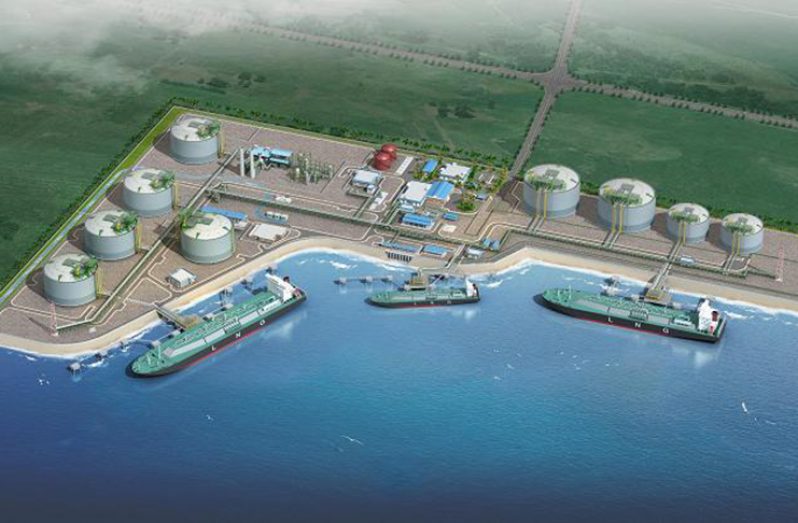…sees range of employment opportunities, reduction of energy costs
THE coalition government has plans for the establishment of a Natural Gas Terminal which it envisions will create opportunities for employment for many Guyanese, while significantly reducing energy costs.
This plan is embedded in the A Partnership for National Unity + Alliance for Change’s (APNU+AFC) manifesto launched on Friday. The manifesto, along with its track record, are the positives being put forward by the administration in a bid for re-election.
A natural gas terminal is a structure for the storage of liquefied natural gas which can comprise of special tanks, ships, building structures, port infrastructures and pipelines. In its most recent find, ExxonMobil increased its estimated recoverable resource base for oil and gas in Guyana to more than 8 billion barrels. Director of the Department of Energy, Dr. Mark Bynoe, has stated that of this 8 billion, some 2 billion is estimated to be gas.
Natural gas is well recognized as one of the cleanest energy alternative and the Department of Energy has been making preparations to get natural gas on shore by 2023. With the possibilities already laid out, the department has started to examine potential sites where a “gas pipeline” can land, hoping to land the same by 2023 and 2024.
Meanwhile, Minister of Public Infrastructure, David Patterson, has also put forward the plan in 2019 for the establishment of a power plant through which the country can see its
energy needs being met. “What we are doing is building out the architecture. It comes in by pipeline and we will have a 188 megawatt power plant,” Patterson said in August 2019.
“The money that you save that would have previously used to buy diesel and fossil fuel to run GPL, you can put that back into the economy.” On another occasion he told Kaieteur News that ExxonMobil is capable of providing 30 to 50 million cubic feet of natural gas from the Liza Phase One Project alone for electricity generation. He said that this is enough to power the entire country for over 15 years and is enough to provide Guyana with four times the quantity of cooking gas that is used per day.
MEETING ENERGY NEEDS
At present, the Guyana Power and Light Inc. (GPL) falls short of the total reserves needed in the system. While the international convention demands 10-15 per cent of reserves that function in cases of emergencies, GPL stands at 8 per cent. With a new power plant in operation, it is expected to produce a surmountable amount of energy unlike any existing power plant in Guyana. It will also result in astronomical savings for the country since power generation costs will decrease.
Currently, approximately 18 per cent of the country’s primary energy supply is derived from renewable energy – predominantly in the form of bagasse, firewood and solar PV — while the remaining 82 per cent of primary energy supply is sourced from imported fossil fuel – primarily diesel, heavy fuel oil and gasoline. On average, approximately 1,836,300 barrels of fossil fuel are used to generate electricity annually, according to the Guyana Energy Agency (GEA)’s Chief Executive Officer (CEO), Dr. Mahender Sharma.
This translates to an estimated US$139.30 million on a yearly basis, based on the average consumption from 2015 to 2018. “With the emergent oil and gas sector, there is also an opportunity to utiltise the associated gas from the oil production for electricity generation. As such, a combination of renewable energy and natural gas can be the primary energy sources to accommodate Guyana’s energy needs,” Dr. Sharma said in 2019.
He posited that future studies will provide more details on specific quantities to be used; however, the majority of needs would be met via natural gas and hydropower with smaller installation of solar PV farms, wind farms, cogeneration plants and gasifiers. The initiative would also comply with the Government’s Green State Development Strategy (GSDS) Vision 2040, which seeks to ensure oil extraction in association with natural gas production is done most beneficially.
Natural gas is said to be a mixture of gases which are rich in hydrocarbons. All these gases (methane, nitrogen, carbon dioxide) are naturally found in the atmosphere. Natural gas reserves are deep inside the earth near other solid and liquid hydrocarbon beds like coal and crude oil. Natural gas is not used in its pure form; it is processed and converted into cleaner fuel for consumption. Many by-products are extracted while processing natural gas like propane, ethane, butane, carbon dioxide, nitrogen and so forth, which can be further used.



.jpg)











